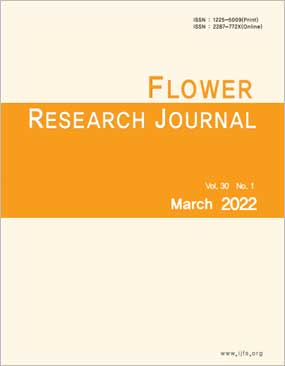서 언
칼랑코에(Kalanchoe blossfeldiana)는 장미목(Rosales), 돌나무과(Crassulaceae), 칼랑코에속이며, 마다가스카르섬이 원산지로 아시아, 남아프리카 등에서 자생하고 있다(Muzitano et al. 2009). 칼랑코에는 19세기 유럽에서 관상 목적으로 재배되었으며, 개화기간이 길고 관리가 용이해 많은 나라 소비자들에게 인기있는 분화식물로 자리잡았다. 특히, 분화 칼랑코에는 다양한 화색과 소화 수가 많은 개량종으로 분화시장에서 주목받고 있으며, 국내 소비도 꾸준히 유지되고 있다(Cho et al. 2020;Muzitano et al. 2009).
칼랑코에의 주요 관상부위는 꽃과 잎이며, 초장이 짧고 분지와 소화가 많은 식물체가 상품성 및 선호도가 높다(Kahraman et al. 2021). 또한 칼랑코에는 CAM 식물로, 야간에 기공을 열어 이산화탄소를 흡수하고 주간에 기공을 닫아 수분손실을 줄이고 탄소를 고정하여 탄수화물을 형성한다(Drennan and Nobel 2000). 따라서 C3 식물에 비해 건조한 기후와 배지조건에서도 생존할 수 있는 수분 보유 능력이 있고, 특히 잎이나 줄기에 수분을 저장하여 생명을 이어간다(Kahraman et al. 2021).
분화는 농가에서 운송 시 포장으로 인한 암조건, 에틸렌 발생, 변온, 고습, 진동 등 다양한 환경요인이 최종 유통단계에서의 분화 품질에 영향을 준다(Ferrante et al. 2015). 칼랑코에 국내· 외 출하 시 분화 전용 비닐 개별포장 및 박스 운송을 진행하기 때문에 운송 동안 배지 내의 과수분 조건으로 인한 곰팡이병이 발생한다. 반면 배지 내 수분 부족은 지제부의 수분 손실로 인한 생장 저해가 발생하여 출하 후 잎과 꽃마름 증상이 나타난다(Kwon and Park 2003). 근권부 수분 손실은 뿌리의 수분 포텐셜 저하, 기공 감소, 세포 팽압 감소, 증산 작용 저하 등 다양한 수분 생리장해 등을 유발하며 결국 분화의 품질 저하로 이어진다(Limpus 2009).
재배 단계에서의 근권부 수분 함량 관련 연구는 일부 진행되었으나, 출하 후 칼랑코에 분화 배지 내 수분함량에 따른 품질 연구는 미흡한 실정이다(Cho et al. 2020;Kwon et al. 2003a;Kwon et al. 2003b;Lu and Son 2005;Noh and Son 2010;Oh et al. 2007;Park et al. 2009).
따라서 본 연구는 국내 유통 후 분화 칼랑코에 배지 수분함량에 따른 분화품질 및 수명차이를 분석하고자 수행하였다.
재료 및 방법
식물재료 및 배지 내 수분 처리
식물재료는 경기도 고양시 소재 칼랑코에 농가에서 재배된 분화 칼랑코에(Kalanchoe blossfeldiana) ‘Queen Bell’이며, 직경 10cm 포트 식재묘를 사용하였다. 출하단계의 칼랑코에는 국내 유통과정과 동일하게 포장 및 운송(1시간 내, 트럭운송)을 진행하여 전남대학교 원예품질관리학연구실로 수송되었다. 온도 24±2℃, 상대습도 53±4%, 광(형광등, 35.2±2μmol·m-1·s-2, 12h)이 유지되는 생장챔버(VS-91G09M-1300, VISIONBIONEX, Korea)에서 3일 동안 순화과정을 거쳤다(Lee and Lee 2024). 챔버 내 환경은 온·습도 데이터 로거(UX100-011A; ONSET Hobo, USA)를 사용하여 1시간 간격으로 측정하였다. 근권부 수분함량 처리를 위해 10개 화분을 주 1회 1.5L 저면관수 트레이에서 1시간, 20분, 5분 동안 배치하였고, 배지 내 수분 함량(Substrate moisture content, %)을 고습(≥90%), 중습(40~55%), 저습(10~30%) 3 수준으로 처리하였다. 또한 배지 내 수분함량은 매주 토양수분 측정기(DM300L, YIERYI, China) 센서를 토양표면으로부터 약 3cm 삽입하여 측정하였다.
분화 칼랑코에 개화 지속성
분화수명은 전체 소화의 75%가 노화되었을 때 수명을 종료하였다(Leonard and Nell 1998). 분화수명 종료증상은 꽃 위조 및 탈리, 잎의 황화로 구분하여, 각 증상이 일어나는 화분 수를 전체 화분 수 대비 백분율로 나타냈다. 특히 잎의 황화는 잎이 20% 이상 나타나는 시점으로 설정하였다(Jeong et al. 2021).
분화 칼랑코에의 형태적 품질
칼랑코에 형태적 요인으로 초장, 지상부너비, 전체 꽃눈 수, 개화된 꽃 수, 개화율, 출하대비 개화율를 측정하였다. 초장은 지제부에서 화서 끝부분까지 수직으로 측정하였고, 지상부 너비는 좌우 가장 넓게 퍼진 잎 가장자리까지의 길이로 설정하였다 (Kwon et al. 2003a;Song et al. 2006).
전체 꽃눈 수는 칼랑코에 분지 중 50mm 이상인 화아, 화서 내 소화의 높이가 50mm 이상인 꽃을 기준으로 10% 이상 개화한 꽃 수를 조사하였다(Cho et al. 2020). 개화율은 (개화된 꽃수/전체 꽃수)×100, 출하대비 개화율은 (조사 날의 개화된 꽃수/0일째 개화된 꽃수)×100 식에 따라 계산하였다(Park et al. 2009).
분화 칼랑코에의 생리적 품질
모든 생리적 품질은 관수 전 측정 및 분석하였으며, 지상부의 생체중은 뿌리에서 배지를 제거 후 뿌리에서 가장 가까운 줄기 시작점을 절단하여 측정하였고, 지하부는 절단된 뿌리를 측정하였다(Vieira and Ferrarezi 2021). 지상부 및 지하부 건물중 측정을 위해 절단한 시료를 드라이 오븐(KED-132A, Kiturami, Korea)을 이용하여 50℃에서 72시간 건조하였고, 잎의 엽록소 함량은 SPAD(SPAD-502PlusMINOLTA, Japan)를 이용하여 식물체 두 번째와 세 번째 마디의 완전 전개된 바깥쪽 잎을 기준으로 측정하였다. 엽록소함량 측정 기준 잎을 이용하여 암적응 클립(Dark leaf clip, WALZ, Germany)을 이용하여 암처리(20분) 및 엽록소형광 측정기(MINI-PAM-II, WALZ, Germany) 활용한 광계 II 최대 양자수득률(Fv/Fm)을 측정하였다(Lee and Lee 2024).
기공 크기 조사를 위해 두 번째 마디 바깥쪽 잎 뒷면에 투명 매니큐어를 가로로 약 2cm 도포하여 10분 후 유리테이프로 본 떠 슬라이드글라스(Microscope slides, Scilab, Korea)에 부착 후 광학현미경(Primostar 4, ZEISS, Germany) 400배율에서 관찰하였다(Lee et al. 2020). 암조건과 명조건 각각 12시간 처리하여 공변세포와 기공의 가로 및 세로 길이 측정 후 타원 넓이 공식으로 기공 넓이를 계산하였고, (명조건 기공넓이/암조건 기공넓이)×100%에 따라 기공크기 변화율(%)을 분석하였다 (Choi and Lee 2020;Yi et al. 2018).
꽃잎과 잎 온도 측정을 위해 촬영 전 10분 동안 크립톤 전구(60W)로 식물에 열처리 진행 후열화상 카메라(FLIR T560, FLIR Systems Inc., USA)를 사용하여 암상태에서 촬영하였다. 꽃잎 온도 측정은 상부에서 봤을 때 완전 전개된 꽃잎을 측정하였으며, 엽온은 식물체 세번째 마디의 바깥쪽 잎을 지정하였다. 열화상 이미지는 FLIR Tools+프로그램(FLIR Systems Inc., USA)을 통해 온도 변화를 분석하였다(Choi and Lee 2020).
통계분석
통계분석 프로그램인 SAS package(Statistical analysis system, version 9.4, SAS Institute Inc. USA)를 이용하여 ANOVA 분석(analysis of variance)과 DMRT(Duncan’s multiple range test)로 처리 간 유의성 분석을 하였으며, 모두 5% 수준으로 하였다.
결과 및 고찰
분화 칼랑코에 개화 지속성
국내 유통 후 배지 수분함량을 고습(≥90%), 중습(40~55%), 저습(10~30%)으로 처리한 결과, 저습처리가 고습과 중습 처리보다 분화수명이 36.8~42.3% 단축됐다(Table 1). 분화수명 종료증상 중 꽃잎 위조는 모든 처리구에서 100%로 나타났고, 꽃잎 탈리는 저습 처리보다 고습과 중습 처리구에서 더 높게 나타났다. 본 연구에서는 모든 처리구에서 꽃잎 위조가 100%로 나타나 분화 칼랑코에는 배지 내 수분함량과 관계없이 수명 종료 후 꽃잎 위조가 높게 나타나는 것을 알 수 있었다. 분화 수명 종료 시 잎의 황화현상은 저습 처리가 100% 나타나 고습과 중습 처리보다 높게 나타났다(Table 1). 잎 황화현상의 발생율이 높았던 저습 처리는 잎의 가장자리부터 빠르게 위조되면서 잎이 부서졌으며, 추후 탈엽으로 이어졌다. 배지 내 저습 처리로 인한 수분 스트레스는 잎의 경도를 감소시키고, 작은 물리적 마찰로도 쉽게 상처를 입으며, 잎의 황화현상을 빠르게 진행시킨다(Hou et al. 2010).
분화 칼랑코에의 형태적 품질
분화의 초장은 출하 후 분화수명 종료시점인 4주차에 차이는 없었으며, 식물폭은 저습 처리가 고습과 중습 처리보다 13.4~ 15.4% 낮았다(Fig. 1A, 1B). 분화는 전체적으로 초장과 식물폭의 균형미가 있고, 캐노피가 콤팩트한 식물이 상품가치가 높다 (Eveleens-Clark et al. 2004). 그러나 본 연구에서 저습 처리가 수분 손실로 인해 잎이 아래로 처지면서 식물폭이 감소하는 경향을 보였다. 전체 꽃눈수와 개화된 꽃수는 출하 후 1주차에는 처리간 차이가 없었으나, 4주차에 저습 처리에서 고습과 중습 처리구보다 낮았다(Fig. 1C, 1D). 개화율은 모든 처리구에서 시간 경과에 따라 증가하였으나, 출하 대비 개화율은 2주차에 저습 처리에서 높았다가 3주 이후부터 꽃잎의 조기 위조와 탈리로 인해 감소하였다(Fig. 1E, 1F). 이전 연구에서 분화 안젤로니 아는 생육 시 배지 내 수분함량이 10%인 분화는 40%보다 꽃눈 수, 정상 꽃수, 노화 꽃수가 적었다(Jacobson et al. 2015). 본 칼랑코에 연구에서도 저습 처리에서 출하 대비 개화율이 2주 차에 일시적으로 증가하였으나 3주 이후 노화가 빠르게 진행되어 관상가치가 낮아졌다. 따라서 배지 내 수분함량이 분화 칼랑 코에의 개화에 영향을 미친다는 것을 알 수 있었다.
분화 칼랑코에의 생리적 품질
지상부의 생체중 및 건물중은 출하 후 1주차에는 처리간 경향이 없었으며, 출하 후 5주차에는 처리간 차이가 없었다(Fig. 2A, 2C). 반면 지하부의 생체중 및 건물중은 출하 후 1주와 5주차 모두 저습 처리가 고습과 중습 처리보다 모두 낮았다(Fig. 2B, 2D). 분화 국화의 경우 전체 생체중과 건물중이 1일 3회 관수 처리가 1일 9회 관수 처리보다 더 낮았던 연구 결과가 있다 (Kim and Kim 1999). 분화 칼랑코에의 경우, 배지 내 수분 저습처리로 인한 수분 스트레스는 지상부보다 지하부의 생체중에 더 영향을 미친 것을 알 수 있었다. 잎의 엽록소함량은 출하 후 4주차에 처리간 차이가 없었다(Fig. 3A). Fv/Fm 값의 변화는 비광화학적 소멸 효율 변화를 반영하고, 암적응된 잎의 광합성 잠재력을 평가하는 지표로 사용한다(Gorbe and Calatayud 2012;Oh et al. 2014). 분화 칼랑코에 잎의 Fv/Fm 값은 출하 후 1주차에 0.76~0.78로 나타났으며, 출하 후 4주차에는 저습 처리구에서 0.71로 낮았지만 처리간 유의차가 없었다(Fig. 3B). 건전한 식물 잎의 Fv/Fm 값은 0.78~0.84 범위이며, 이보다 낮은 값은 식물이 환경 스트레스에 노출되었음을 의미한다 (Pagter et al. 2008). 본 연구에서는 출하 후 4주차에 Fv/Fm 이 0.71~0.72로 정상범위보다 낮아 노화증상이 나타난 것으로 보인다(Fig. 3B). 출하 후 1, 4주차의 잎 기공크기 변화율은 배지 내 수분처리에 따른 경향 및 차이가 나타나지 않았다(Fig. 3C, 3D).
열화상카메라를 이용한 대기온도와 식물의 온도 측정은 식물의 수분 상태를 모니터링할 수 있는 지표로 사용되며, 분화 자몽, 스위트 오렌지, 감나무 연구에서 배지 내 건조 처리구가 정상 관수 처리구보다 식물 온도가 더 높았다(Ballester et al. 2013;Vieira and Ferrarezi 2021). 대기온도와 칼랑코에의 꽃잎 및 잎 온도 차이를 분석한 결과, 출하 후 1주차에는 배지 내 수분처리에 따른 차이가 없었다(Table 2). 출하 후 4주차의 꽃잎과 잎의 온도는 고습처리에서 중습처리보다 낮았고, 저습처리에서 중습처리보다 높았다(Table 2). 배지 내 수분 부족은 식물의 기공 전도도를 감소시켜 증산을 억제하고 엽온을 상승시킨다는 연구결과와 유사하였다(Ballester et al. 2013). 또한 기존연구에서, 노화가 시작된 절화 장미는 가시적 노화 증상이 일어나기 전 꽃잎의 온도가 상승한다는 결과와 유사하였다(Choi and Lee 2020).
결론적으로 분화 칼랑코에는 건조한 배지조건에서도 생명을 유지하는 CAM 식물임에도 불구하고, 국내 출하 후 배지 내 저습(10~30%)처리는 고습(≥90%)과 중습(40~55%)처리에 비해 분화수명을 단축시켰고, 잎의 황화현상을 증가시켰다. 특히 분화 수명 종료 시점에서 저습처리는 식물 폭, 전체 꽃눈수, 개 화된 꽃수, 출하 대비 개화율, 지하부의 생제중 및 건물중을 감소시켰고, 꽃잎과 잎의 온도를 증가시켰다. 따라서 출하 후 배지 내 수분함량은 분화 칼랑코에의 수명과 품질에 영향을 미치는 중요한 환경요인이며, 배지 내 수분 함량이 40% 이상 유지시켜야 수분스트레스로 인한 품질 저하가 나타나지 않는다는 것을 알 수 있었다.


















